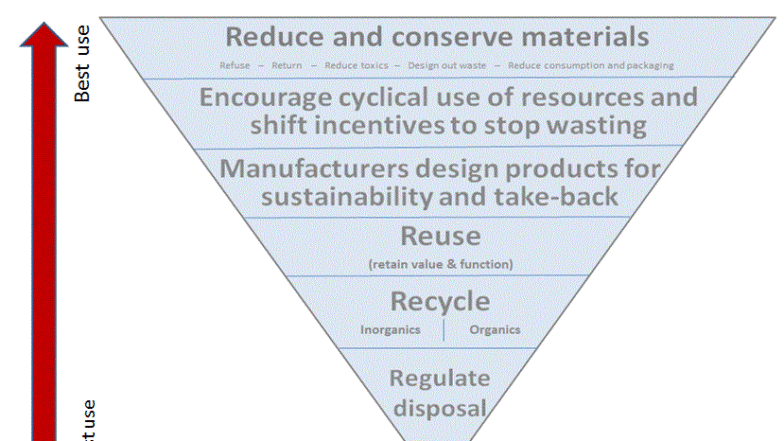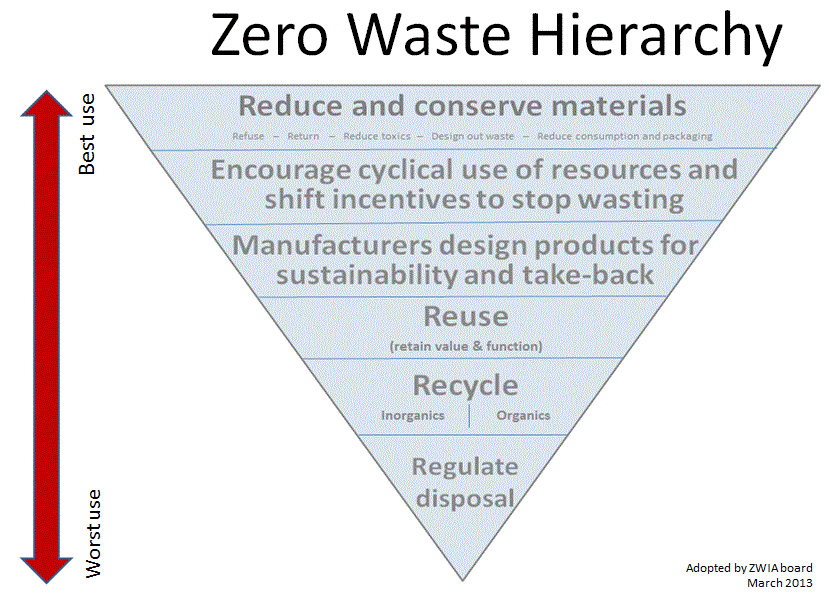From the 3Rs to the Zero Waste hierarchy

One of the secrets of the success of the Zero Waste practices is to follow a more ambitious waste hierarchy than that of the EU.
 Have you heard of the 3R, Reduce, Reuse Recycle? This was the first waste hierarchy that was popularised. Even Jack Johnson wrote a song about it.
Have you heard of the 3R, Reduce, Reuse Recycle? This was the first waste hierarchy that was popularised. Even Jack Johnson wrote a song about it.
It is true that recycling should be the last step in the waste hierarchy but unfortunately in Europe still 60% of the waste goes to landfill (37%) and incineration (23). And it has been like this since quite some years now. Also, the current EU legislation and incentives don’t seem to be working to move waste up the hierarchy and for this reason many directives will be revised in the next years.

One of the secrets of the success of the Zero Waste practices is to follow a more ambitious waste hierarchy than that of the European Union. Still today most incentives in the EU go to the lower part of the hierarchy, which is causing that waste moves from being landfilled to being incinerated.
The board of the Zero Waste International Alliance (in which Zero Waste Europe participates) met in March 2013 to define the steps of a more detailed and effective waste hierarchy which focuses on designing waste out of the system instead of trying to perfect bad ideas such as incinerators or landfills.
Following this hierarchy allows to effectively phase out waste, save energy, create new jobs and sustainable business opportunities. The experiences of Zero Waste municipalities around the world are a living prove of it.
Zero Waste Hierarchy of Highest and Best Use (1)
From Highest and Best Use to Lowest/Worst Use
Reduce and conserve materials
Refuse – Encourage producers to provide products or packaging that limit waste or emissions.
Return – Set up systems that require producers to take back products and packaging that create wastes or emissions.
Reduce toxics use – Eliminate toxic chemicals use; replace them with less toxic or non-toxic alternatives.
Design out wasting – Identify why materials are discarded and redesign the system to be more efficient and no longer discard those materials.
Reduce consumption and packaging – Use less; buy less and with less packaging; avoid disposables; bring your own.
Encourage cyclical use of resources and shift incentives to stop wasting
– Shift government funds or financial incentives (at any and all levels) from supporting harvesting and use of virgin natural resources to support the circular economy.
– Government and businesses should implement sustainable purchasing that support social and environmental objectives.
– Ensure incentives are in place for cyclical use of materials and disincentives in place for wasting (policies, research funds, regulations, etc)
– Set up systems to encourage local economies.(for example. use of proximity principle, marketing support, policies, incentives, social and environmental purchasing practices, information exchanges, etc.)
Manufacturers design products for sustainability and take-back
– Design to be durable, to be repairable, to be reusable, to be disassembled, to be fully recyclable, from reused, recycled or sustainably-harvested renewable materials designed for easy disassembly.
– Label products to identify who has made it and what it is made of.
– Minimize volume and toxicity of materials used in production.
– Lease services and products rather than just sell products to customers.
– Take products and packaging back after they are used, and reuse, or recycle them back into the economy or nature.
Reuse (retain value and function)
– Reuse products.
– Repurpose products for alternative uses (e.g. old doors made into walls; old photos and scrap metal into art).
– Repair to retain value and usefulness.
– Refurbish.
– Remanufacture with disassembled parts.
– Dismantle to obtain parts for repairing and maintaining products still in use.
– Encourage thrift stores, used building materials store, garage sales, flea markets, and charity collections.
– Encourage or allow licensed recovery of reusable goods from tipping areas of discards collection and processing facilities.
– Provide incentives to takeout customers to bring their own containers, coffee cups and bags.
– Organize household hazardous waste swap meets.
Recycle discards safely, efficiently and locally:
A) Inorganics (little or no carbon)
– Build only “Clean” Materials Recovery Facilities (MRFs) and sort source separated materials at such MRFs.
– Recycle all inorganic materials (e.g., soils, metals, glass and ceramics).
– Downcycling is lower priority (e.g., recycling single-use products into 1 time uses or making mixed glass into sand).
– Develop local markets and uses for all recovered materials, including Resource Recovery – Parks, Residual Research Centers, and business clusters to reuse, recycle or compost products and packaging for highest value and efficiency.
– Use existing “Dirty” MRFs only to pre-process mixed discards before burying in landfills, as – Dirty MRFS do not benefit generators & produce lower quality materials.
B) Organics (carbon-based)
– Edible food to people first; animal feed second; compost or digest the rest, back to land as compost or digest for fuel depending on where nitrogen is needed most locally.
– Promote on-site composting by homes and businesses.
– Use lower tipping fees to create clean flows of plant debris, unpainted wood, other compost feedstocks.
– Compost yard trimmings, discarded food and food-soiled paper in aerobic windrows and place organics back in soil.
– Use in-vessel systems for organics in built-up urban areas.
– Maintain source separation for highest and best use of organics.
– Combine source separated organics with bio-solids only if biosolids have been tested to ensure they will not contaminate end products and they are not applied on food crops.
– Regulate disposal, dispersal, or destruction of resources
– Ban materials or products that are toxic or that cannot be safely reused, recycled or composted.
– Recover Energy/Bio-fuels only using systems that operate at biological temperature and pressure, such as sustainable biodiesel from used vegetable oils or biologically or chemically producing ethanol from urban wood, biosolids, manures or food scraps.
Landfilling is the last step.
– Materials sorting for recyclables and research for design purposes.
– Biological stabilization before burial
– Require insurance to cover post-post-closure repairs.
– Plan systems to be flexible to be adjusted towards Zero Waste with changes in waste stream as waste is reduced.
Not Acceptable
– Don’t support bioreactor landfills
– Don’t burn mixed solid waste, tires, wood from mixed construction and demolition debris, or biosolids. High temperature systems volatilize heavy metals and produce dioxins and furans. Avoid: Mass Burn, Fluidized Bed, Gasification, Plasma Arc, and Pyrolysis.
– Don’t give recycling credit for Alternative Daily Cover (ADC) or “beneficial use” of processing residues to build landfills.
– Don’t allow recycling toxic or radioactive wastes into consumer products or building materials.
(1) Prepared by Gary Liss, [email protected], www.garyliss.com, with input from International Dialog in Berkeley, CA and adopted by ZWIA Board on 3/20/13.